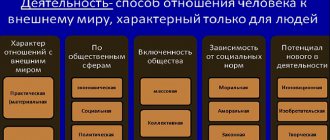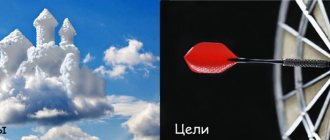Any human meaningful activity is expedient and motivated by internal or external reasons. It transforms the surrounding reality, and therefore it is important to understand the goals and driving motives of the individual through the specified criteria. Why is this important? To predict cause-and-effect relationships and the results of an individual’s activities. Both the subject of activity and the society surrounding him will use these criteria for their own purposes.
Activity
This is a person’s conscious activity aimed at satisfying personal and social needs, having a specific goal and motive. All human activities shape the process of development of society.
Activity is a form of realizing the goals of people in society. In its process, both the external world as an object of conscious influence and the person himself are transformed. This happens as a result of improving knowledge about the world and one’s capabilities. Therefore, it is so important to know and take into account the motivating motives of activity and the direction of actions of people in society, since ultimately they form the system of social life of society, and their effectiveness depends on motivation.
Various disciplines pay attention to human activity. Sociology views it from the point of view of social significance. Philosophy is for analyzing the meanings and values in people’s actions; for psychology, the structure and types of human activity are important from the point of view of the mental orientation of the individual; for management, it serves as a tool for motivating employees.
In the process of studying different areas of humanitarian knowledge, a single basis was identified that characterizes the process of activity. This structure and its elements constitute the principle of purposeful activity, which is preserved in all its types.
22.Interpersonal relationships. Psychological climate and compatibility.
The degree of compatibility of people has the greatest influence on the psychological climate. Psychological climate is the emotional coloring of the psychological connections of team members, arising on the basis of their sympathy, coincidence of characters, interests, and inclinations.
Climate:
1. social: determined by awareness of the general goals and objectives of the organization
2. moral - based on the accepted values of the organization
3.psychological - informal relationships that develop between employees.
Psychological compatibility is the ability of people to be close for a long time, live, communicate and interact without clashing in character.
4 types of compatibility:
1.physical (harmonious combination of physical qualities2 or several people performing a joint action)
2.psychophysical (based on the characteristics of analytical systems and the nature of temperament)
3. socio-psychological (the relationship of people with such personal attributes that contribute to the enhanced fulfillment of social roles. harmony is required)
4. social-ideological (assumes a commonality of ideological views, similarity of social charters and values)
Structure of the phenomenon
Any activity has a general nature and direction. The structure of human activity looks quite laconically, the diagram of which can be presented as follows: goal → motive → result. But this chain does not contain all the links. Moreover, it is characterized by the cyclical nature of the process repetition. And the beginning of such a chain is based on the result of previous activity. It is, rather, a spiral that rushes towards the perfection of man and society.
Before setting a goal, a person must feel the need and the motive for activity arising from it. Moreover, the result is not the end of the chain, but serves as the basis for a new stage in the active development of the individual, from setting a goal (task) based on a specific motive to the process of achieving a result using selected techniques and means of achieving it. This is the logical structure and its stages. These are links of one chain, and they act as the structure of human activity:
- Need.
- Motive.
- Target.
- Process.
- Method (way) of implementation.
- Result.
Each element performs a specific function and is important for the entire process. Without an identified need, it is impossible to determine the authorship of the goal. This form of activity does not have a result, or it is alienated from the subject of the activity, does not belong to him and does not serve its purpose, since it makes the whole process meaningless.
If the process replaces the result, people lose interest in this area of activity. If the result does not meet expectations, the individual loses meaning and may degrade due to the lack of the most important quality of human activity - awareness of its goal.
24.Methods for studying interpersonal relationships in production teams and their regulation
Interpersonal relationships are a reflection of objective connections and interactions between people who are members of the same group. The complexity of this phenomenon gives rise to many points of view. Interpersonal relationships can be divided into formal and informal. In the first case, they are determined by a certain formal organizational structure, in the second - by the desires, aspirations, and preferences of people. Official relations are documented and controlled; they are usually strictly regulated. Informal relationships may be recognized and even encouraged by the group, but they are not regulated by any official structure or documents.
There are 4 methods of study: observation method, experimental method, biographical and introspection
Relationships are also divided into business and personal. Business relations are again connected with some socially useful activity - labor, education, and are determined by it. Business relationships are also most often, but not always, secured by job descriptions, some rules, regulations.
Analysis and synthesis
Forms of activity are studied by a complex of social and humanitarian sciences. One of their tasks is to reveal the nature of goal-setting in human activity in order to motivate every member of society to socially significant activity and prevent antisocial motives and antisocial orientation in people’s actions.
Analysis of all elements of the chain allows us to discover cause-and-effect patterns of interaction between motives and results of activities, goals and forms of the process, thereby helping to understand the driving forces of society.
The structure itself does not have a linear orientation. It is repeated, intersects with other forms and methods of action of a person and a group, is absorbed, and sometimes is interrupted without ending in achieving the goal.
Analysis of the structure of activity of a completed cycle gives an idea of the strength of motivation, ways of applying energy to solve problems, and other socio-psychological factors of activity. It can serve as a high-quality tool for creating motivational programs and methods of organizing the labor process.
Knowledge about the causes and conditions for the formation of motives can serve as an effective tool for creating incentive programs in the process of work and professional self-realization of people.
20. The concept of a group. Classification of groups and their socio-psychological characteristics.
A group is a human community, distinguished on the basis of a certain characteristic, for example, class affiliation, the presence and nature of joint activities, characteristics of the organization, etc. Groups: 1. large (represented by states, nations, nationalities and classes).
Through these groups the influence of the ideology of society on the psychology of the people composing them is mediated. 2. small. composition from 2..3 to 20..30 people, whose members are united by common activities and are in direct personal communication (family, school class) - small conditional - small real (actually existing)
Small real ones are divided into:
1. laboratory (for the purpose of scientific research)
2. natural - formal (official: school class). Highly developed - informal (associations of interests: circle).
Underdeveloped.
The purpose of the activity is the leading motivator
The level of a person’s stated goal depends on his culture, capabilities, environment, and social conditions. He cannot always accurately formulate the goal. More often, personal goals are replaced by external attributes of success and values characteristic of a certain moral environment of society. The ability to formulate a personal goal for an activity is an indicator of a person’s personal development.
The purpose of an activity is to comprehend its result. This idea is material, having a spatiotemporal localization.
Goals can be internal, immanent (intrinsic) in human nature, and external, determining the activity of the individual. External and internal goals may coincide. This is the best option for the benefit of society and the individual, since it does not provoke a conflict of interest.
If the external goal does not correspond to the interests of the individual, then the activity can achieve a result, but it is permissible to talk about effectiveness if there is a strong motive for achieving the result. If the goal solves problems that are important to the individual, it itself can act as a powerful motivating factor. So, what is the motive of activity? What role does he play?
Management styles
Authoritarian management style. The authoritarian management style is quite rigid. A leader who adheres to an authoritarian style strives to manipulate and dominate subordinates. He single-handedly makes all management decisions and strictly controls the implementation of the tasks assigned to him. The use of an authoritarian style is possible, and sometimes necessary, in such situations as: lack of order and discipline in the team, the existence of a strict time limit for making some important decisions or introducing changes, the existence of difficult conditions for the functioning of the organization, etc.
disadvantages: - deterioration of discipline in the team - decrease in labor efficiency - staff turnover - lack of creative initiative.
Democratic management style Control over the completion of tasks in a democratic management style is moderate, often based on the self-control of performers, and various incentives are present. The leader in this style of management is friendly, open in communication, tolerant of criticism, delegates authority, tries to create in his subordinates a sense of belonging to the common cause, a spirit of cooperation, and mutual understanding in the team.
Liberal management style. A leader in a liberal management style avoids making any strategically important decisions, is indifferent to criticism, he is not interested in the needs of his subordinates, he does not clearly distribute tasks, responsibilities and rights between them, control on his part is, as a rule, insignificant.
Examples of similar educational works
Study of professionally important qualities of middle managers
... activities, we were able to analyze professionally important qualities as a general and quite significant factor in the success of middle managers. Research methods and techniques: — Expert assessment; — Method of polar groups; ...
Leadership Qualities
... A leader loves people. If the manager's job is to manage people, ... attitudes to various phenomena - the organization's mission, planning, motivational policy, productivity, quality of work ... collective activity. So...
Professional qualities of a leader, psychological characteristics and methods of formation...
... formation of the leader’s personality as a subject of management. Subject of research: professionally significant qualities of a leader. personality leader psychological gender Research hypothesis: the effectiveness of the leader is ...
Educational activities of children in early age groups
... Educational activities of children in early ... development groups. It is not enough to be born a human to become one. ... children's activities: motor, including those associated with performing exercises aimed at developing such physical qualities, ...
Communication qualities of a leader
...organization and management of team activities. In a market economy, the requirements for the business qualities of a manager change. According to statistics, in our country there are more than 10 million leaders of various status groups. But the leader is...
Motivational needs
This concept is so important from the point of view of mental processes that there are numerous theories of human motivation. One of the most famous is Abraham Maslow's hierarchy of needs theory. According to this system, it is the needs that are the internal driver of the individual, they encourage him to create and be creative, and the structure of human activity is based on them. Maslow's scheme consists of several levels:
- The desire to satisfy the physiological need for food, home, warmth.
- Existential needs: safety of life, inviolability of housing, presence of a predictable future.
- Social security: the need for love, the need for people, belonging to a social group.
- Spiritual needs in creativity.
- Cognitive needs.
- Aesthetic. This is the desire for harmonization of the internal and external world, for beauty.
- The need for self-actualization (a person wants to have status, recognition, strives for full self-expression).
All needs that aim at the personal well-being of an individual are basic, primary. The level of a person’s need for recognition by society, the desire to lead a social life - all this is secondary. Such needs are formed when basic ones are satisfied.
Motive
The motive forms the goal, as the structure of the activity shows. The diagram clearly demonstrates the importance of this element. It should be added that all needs are inherent in human nature. But the leading motivator will be the one that solves the most pressing problems in achieving personal goals.
Motive, if we characterize it briefly, is the meaning of a person’s activity, his activity.
In order to understand what a motive for activity is, let’s look at an example.
If a person strives to become a leader, his goal is to acquire the status of a boss, the motive is to satisfy the need for recognition, the result is a high position. In real life, everything is not so schematic and primitive, of course. Motives are often multi-level, as are goals.
23. Psychology of mass socio-psychological phenomena.
Mass psychological phenomena are the simultaneous manifestation of one of the sides by the consciousness of many people. These include:
1. public opinion (a single content judgment of the collective activities of individuals)
2.collective experience (identity of the emotional state of people belonging to a social community)
3. competition (interaction of individuals, teams, groups during which the desire of the parties to surpass each other’s results arises and is realized)
4.imitation (conscious and unconscious copying of a sample)
5.group activities
Methods and modes of activity
Analysis of the structure of activity logically forces us to answer a number of questions.
How are the goal and the result interconnected, how do these moments influence each other? What is the motive of activity? In what way does he manifest himself in the process of achieving the goal?
Indeed, if a motive is an internal engine, then the way or method of achieving a goal is an external form of implementation of an activity. And it must be adequate to the purpose. The correspondence of the methods and methods to the obtained result is a qualitative characteristic of the process. The discrepancy between the forms and content of activity and the set goal can have negative consequences both for the individual and for the immediate environment.
If a person strives to become educated, and his internal motive is the need for knowledge, then purchasing a diploma will never be an adequate form of achieving the goal. Characteristics of the structure of activity always give an idea of the adequacy of the goal, methods and results of the process.
A process is always an action. Characteristics of the structure of activity of different options give an idea of possible ways of development of events. Actions can lead to a result, then they form a useful process. Actions at the level of affects, habits, false beliefs, misconceptions regarding the goal are inappropriate and lead to unpredictable results.
21. The concept of a team and their classification. The relationship between the concepts of “group” and “team”
A team is a group where interpersonal relationships are mediated by the socially valuable and personally significant content of joint activities.
| In the diffuse group: | A team: |
| · a person’s position is unstable and uncertain, so he is timid and unsure of his actions; · the leader of the group is random, there is no guarantee that leadership will not be seized by a person of antisocial orientation; · attitude to the matter is regulated by the administration; for the majority - some kind of coercion; · treating the leader as a superior person vested with authority over everyone; · attitude towards the group is protective and defensive; · psychological tightness, stiffness, timidity towards oneself; · in relation to another - hidden aggression, competition. | · a person’s position is stable, definitely, therefore he is free in behavior; · the leader of the group is a person respected by the majority or everyone with a social and value orientation; · attitude towards the matter as personally significant for each member or for the majority; · treating the leader as the most experienced and skillful comrade whom the group has empowered; · open, friendly attitude towards the group; · in relation to oneself - free manifestation of the “I”, initiative; · in relation to another - acceptance as a given, friendship. |
Team requirements:
1. group must be effective in relation to core activities
2. the group must have high morals
3. create for everyone in the group the opportunity to develop as an individual.
4.be capable of creativity.
Activities
The activities are varied. The chosen path depends on various parameters - age, profession, status, field of activity. Let's look at some types to see how the psychological structure of human activity changes.
This process does not begin with adulthood, when a person becomes able to make free and independent choices with a full degree of responsibility. Activities are carried out from the very first days of life. Only the degree of her awareness and motivation changes.
An infant, like a mature personality, has a goal, but it cannot yet be called conscious. But he is driven by a strong motive - the satisfaction of physiological needs. He already carries out activity at the subconscious level of reflexes.
Next, play activities are added. In childhood, she is the leader. At this stage, the general structure of the activity already manifests itself. It reflects Maslow’s entire hierarchy of needs in a condensed form.
The next natural stage is human educational activity. Its goal is to acquire new knowledge, skills and abilities. This is a very significant activity.
It is present at all stages of human life. It can be said differently: any type of activity performs an educational function.
As a rule, in the labor process, the individual’s purposeful activity is fully realized. Ultimately, a product is produced that satisfies the current needs of society.
The result of the creative process is a work of art. The desire for self-expression is contained in the structure of activity. The diagram demonstrates the close connection between this motive and the goal: motive of self-expression ↔ method ↔ goal. But it does not necessarily take place only in a creative environment. The element of creating something new is present in all forms of human activity, but to varying degrees, of course.
Psychology of the management process.
Management psychology is a branch of psychology that studies the psychological patterns of management activity. The main task of management psychology is to analyze the psychological conditions and characteristics of management activities in order to increase the efficiency and quality of work in the management system. The management process is implemented in the activities of the manager, in which management psychology highlights the following points: diagnostics and forecasting of the state and changes of the management subsystem; formation of a program of activities of subordinates aimed at changing the states of the controlled object in a given direction; organization of execution of the decision. In the personality of a manager, management psychology distinguishes between his managerial needs and abilities, as well as his individual management concept, which includes a super task, problematic content, management plans and principles and rules of management internally accepted by the individual. The management subsystem studied by management psychology is usually represented by the joint activities of a large group of hierarchically interconnected managers. Basic methods of management psychology Management psychology as a science is based on various psychological methods, the main of which are observation and experiment.
By its nature and essence, observation is a complex objective psychological process of reflecting reality. Its complexity is determined by the fact that it is carried out in the natural setting of the functioning of the organization, in which the place and role of the researcher as an observer has a certain influence and impact on the observed, on the one hand, and on the selection and synthesis of information, on the other. In addition, in most cases, the role of the researcher is passive, since he only records the manifested opinion or attitude of people towards processes, facts and phenomena.
An experiment is one of the most unique and difficult to master methods of collecting information. Carrying out the experiment allows us to obtain very unique information, which is simply not possible to obtain by other methods. For example, in order to increase labor productivity, the enterprise decided to use a number of new forms of moral and material incentives. However, it is unclear whether this will lead to the desired result or, on the contrary, will it entail negative consequences and reduce the effect of using previously introduced and established forms of reward for conscientious work? Here an experiment comes to the aid of the manager, which, due to its capabilities, can “play out” a certain situation and “give out” valuable information. The main purpose of it is to test hypotheses, the results of which have direct implications for practice and various management decisions.
Result
The final stage for which any activity is carried out is the planned result. If it does not meet expectations, a person may experience frustration - a mental state that characterizes internal devastation and disappointment. Naturally, this kind of phenomenon does not contribute to success and further goal setting. That’s why it’s so important that the result brings joy. The latter must be distinguished from pleasure. A person experiences joy if he puts effort into the process to obtain a result. In this case, the result itself is a logical motivator for further activity, because people tend to strive for positive emotions.
The result is the final product of human activity. At the same time, it must meet the goal. The structure of human activity coincides in this phase. Having achieved the goal and received the result, the individual reaches a new level of need that needs to be satisfied.
The result often appears in the form of a product, but it does not always have a material shell.
The result can be a goal that brings joy from the work process. If the result of an activity corresponds to the goal, then the person has achieved a positive result. If not, then a negative experience is formed, which should also be taken into account when making plans for the future.
Rational activity and personality
Human activity, the purpose of which is self-improvement, deserves special attention. During the implementation of this process, the structure of human activity has personal potential as its subject and basis. Each person has this opportunity. But not every person is ready to work on themselves. Only a highly developed individual understands that he himself is the best subject of his own development. What features does this process have?
- The ability to be fully responsible for the results of one’s development.
- The ability to achieve success in activities in which a person realizes himself fully.
- The goal has a deep life meaning, usually significant for society, going beyond the personal needs of the individual.
- A high level of organization of personal space, subordination of the way of life to the set goal.
It should be noted that any human activity, the purpose of which satisfies him, is an element of self-improvement. The fact is that joy is always the discovery of one’s own boundaries and possibilities. In addition, it also provides a positive attitude, which encourages others to work together and helps increase the energy of this process.
Even Aristotle, the father of Logic, called purposeful activity a great benefit for society and man. All the true values of life acquire even greater significance over time. Aristotle's words are undoubtedly relevant to this day.
Self-test questions
- Remember the four main types of activities and reveal the meaning of each of them.
- Who can be the subject of the activity?
Vaska the cat.
- Chemistry teacher.
- Students of class 5A of secondary school No. 151.
- Population of the DPRK.











